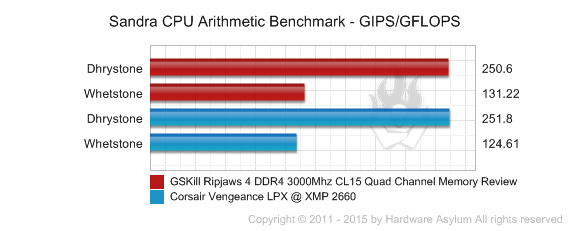GSKill Ripjaws 4 DDR4 3000Mhz CL15 Quad Channel Memory Review
Author: Dennis GarciaBenchmarks - Synthetic
MSI X99A Godlike – X99 Chipset
Intel Core i7 5960x (3.0Ghz) Octo Core 8 x 256KB L2 Cache 20MB L3 Cache
Thermaltake Water 2.0 Extreme
1x EVGA GTX 980Ti SC+
Micron C300 128GB SSD
HP dvd1260i Multiformat 24x Writer
Thermaltake Toughpower Grand 1050 Watt PSU
Windows 7 Ultimate 64bit SP1
Memory Tested
4x GSKill Ripjaws PC4-24000 16GB DDR4 (15-15-15-35)
Reference Memory
4x Corsair Vengeance LPX PC4-21300 16GB DDR4 (15-17-17-35)
Sandra is a software collection of synthetic benchmarks that will give us a basic idea as to what a system is capable of. It should be noted that SiSoft numbers can change depending on what hardware is being tested. These were recorded using Sandra Professional Version 21.15.2015.1


AIDA64 Extreme Edition is a streamlined diagnostic and benchmarking software package designed to assist with overclocking and general system tuning. The package also contains modules to assess the performance of the processor, system memory, and disk drives in addition to normal stuff like stress testing and troubleshooting.


Unigine is a synthetic benchmark much like 3DMark Vantage, but supports the newest of DirectX 11 technologies. The benchmark comes with lots of heavy tessellation and soft shadows to work the more flexible shaders found on DirectX 11 graphic cards. This makes this benchmark ideal for seeing exactly what a best case scenario might look like for a DirectX 11 capable GPU.
Benchmark Settings
HWBot Benchmark
DirectX 11 Presets
DirectX 9 Presets

Crysis is based in a fictional future where an ancient alien spacecraft has been discovered beneath the Earth on an island off the coast of China. Crysis uses DirectX 10 for graphics rendering. For this benchmark we are using the Crysis Benchmarking Tool to run the Assault Harbor demo at 800x600 with global quality set to High.

Call of Duty 4 is a very fast paced first person shooter based on modern warfare tactics and weapons. The game is based on DirectX 9 technology and really shows that game developers can make incredible looking games using older technology. For this benchmark we are using a custom timedemo that was recorded during an actual online multiplayer game. The demo is then replayed as a benchmark in the game with the average FPS recorded at the end.

When you are dealing with high performance memory modules there is very little that separates them in terms of overall performance. The charts above reflect the performance numbers between the two quad channel memory kits and their XMP profiles. The synthetic benchmark numbers reflect what you would expect, faster memory higher numbers. The surprise comes when we look at the real-world gaming numbers and see only a few FPS change between all of the kits.
Rather amazing given that the only change was the module.



